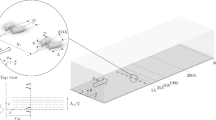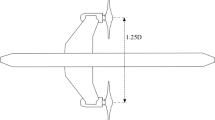Abstract
The rotating stall generated by the centrifugal pump impeller reduces efficiency and causes severe flow fluctuations and noise due to surging. In the present work, the six-bladed impeller in the centrifugal pump was simulated by RANS, LES, and Hybrid RANS/LES turbulence models using ANSYS CFX. The turbulence models considered were the Shear Stress Transport (SST), Detached Eddy Simulation (DES), Stress-Blended Eddy Simulation (SBES), Scale Adaptive Simulation (SAS), and Wall-Adapted Local Eddy-viscosity (WALE). The design load condition and the quarter-load condition were applied for the boundary conditions, and the experimental results were compared and analyzed using velocity profile and turbulent kinetic energy at the impeller mid-height. Under the design load condition, all turbulence models predicted results similar to the experimental results. In the off-design load condition, LES predicted the experimental value most accurately, followed by SST-RM of RANS with high accuracy, and the hybrid RANS/LES model showing lower prediction accuracy; SBES predicted excessive recirculation flow. However, if sufficient grid resolution is achieved, hybrid RANS/LES model can simulate the rotating stall under the off-design flow condition than RANS models. Both DES and SAS model show relatively low mesh dependent results with acceptable accuracy.
Graphical abstract




















Similar content being viewed by others
References
ANSYS (2021) ANSYS CFX theory guide. http://www.ansys.com/
Byskov RK, Jacobsen CB, Pedersen N (2003) Flow in a centrifugal pump impeller at design and off-design conditions: Part II—large eddy simulations. J Fluids Eng 125(1):73–83. https://doi.org/10.1115/1.1524586
Egorov Y, Menter F (2008) Development and application of SST-SAS turbulence model in the DESIDER project. In: Advances in hybrid RANS-LES modeling (pp 261–270). Springer, Berlin Heidelberg. https://doi.org/10.1007/978-3-540-77815-8_27
Grundfos A/S (1997) WinCAPS Catalog. Ver 7.0. Product No: 41260001 CR4-20/1
Huang X, Liu Z, Yang W (2015) Comparative study of SGS models for simulating the flow in a centrifugal-pump impeller using single passage. Eng Comput 32(7):2120–2135. https://doi.org/10.1108/EC-09-2014-0193
Keck H, Sick M (2008) Thirty years of numerical flow simulation in hydraulic turbomachines. Acta Mech 201(1–4):211–229. https://doi.org/10.1007/s00707-008-0060-4
Liu X-D, Liu Z-Q, Huang X-B, Li Y, Yang W (2024) Study on the suitable high-frequency PIV sample for centrifugal pump visualization based on impeller speed. J Vis 27(2):133–148. https://doi.org/10.1007/s12650-023-00953-z
Menter FR (1994) Two-equation eddy-viscosity turbulence models for engineering applications. AIAA J 32(8):1598–1605. https://doi.org/10.2514/3.12149
Menter FR (2008) Private communication
Menter F (2018) Stress-blended eddy simulation (SBES): a new paradigm in hybrid RANS-LES modeling (pp 27–37). https://doi.org/10.1007/978-3-319-70031-1_3
Menter F, Egorov Y (2005) A scale adaptive simulation model using two-equation models. In: 43rd AIAA aerospace sciences meeting and exhibit. https://doi.org/10.2514/6.2005-1095
Nicoud F, Ducros F (1999) Subgrid-scale stress modeling based on the square of the velocity gradient tensor. Flow Turbul Combust 62(3):183–200. https://doi.org/10.1023/A:1009995426001
Pedersen N, Larsen PS, Jacobsen CB (2003) Flow in a centrifugal pump impeller at design and off-design conditions: Part I—Particle image velocimetry (PIV) and laser doppler velocimetry (LDV) measurements. J Fluids Eng 125(1):61–72. https://doi.org/10.1115/1.1524585
Pedersen N (2000) Experimental investigation of flow structures in a centrifugal pump impeller using particle image velocimetry. Technical University of Denmark
Strelets M (2001) Detached eddy simulation of massively separated flows. In: 39th aerospace sciences meeting and exhibit. https://doi.org/10.2514/6.2001-879
Tao R, Wang Z (2020) Comparative modeling and analysis of the flow asymmetricity in a centrifugal pump impeller at partial load. Proc Inst Mech Eng Part A J Power Energy 234(2):237–247. https://doi.org/10.1177/0957650919851921
Tao R, Xiao R, Wang Z (2018) Influence of blade leading-edge shape on cavitation in a centrifugal pump impeller. Energies 11(10):2588. https://doi.org/10.3390/en11102588
Yang Z, Wang F, Zhou P (2012) Evaluation of subgrid-scale models in large-eddy simulations of turbulent flow in a centrifugal pump impeller. Chin J Mech Eng 25(5):911–918. https://doi.org/10.3901/CJME.2012.05.911
Yao Z-F, Yang Z-J, Wang F-J (2016) Evaluation of near-wall solution approaches for large-eddy simulations of flow in a centrifugal pump impeller. Eng Appl Comput Fluid Mech 10(1):452–465. https://doi.org/10.1080/19942060.2016.1189362
Zhou P, Wang F, Yang Z, Mou J (2017) Investigation of rotating stall for a centrifugal pump impeller using various SGS models. J Hydrodyn 29(2):235–242. https://doi.org/10.1016/S1001-6058(16)60733-3
Acknowledgements
This research is supported by the Nuclear Safety Research Program through the Korea Foundation of Nuclear Safety (KOFONS) using the financial resource granted by the Nuclear Safety and Security Commission (NSSC) of the Republic of Korea (No. 1805007) and by Korea Institute of Energy Technology Evaluation and Planning (KETEP) Grant funded by the Korea government (MOTIE) (20224000000440)
Funding
There is no funding source.
Author information
Authors and Affiliations
Corresponding author
Ethics declarations
Conflict of interest
The authors have no conflict of interest to disclose.
Ethical approval
This article does not contain any studies with human participants or animals performed by any of the authors.
Informed consent
Informed consent was obtained from all individual participants included in the study.
Additional information
Publisher's Note
Springer Nature remains neutral with regard to jurisdictional claims in published maps and institutional affiliations.
Rights and permissions
Springer Nature or its licensor (e.g. a society or other partner) holds exclusive rights to this article under a publishing agreement with the author(s) or other rightsholder(s); author self-archiving of the accepted manuscript version of this article is solely governed by the terms of such publishing agreement and applicable law.
About this article
Cite this article
Park, S.H., Lee, G.H., Kim, D. et al. Assessment of the predictive capabilities of various turbulence models for the simulation of rotating stall in the centrifugal pump impeller. J Vis (2024). https://doi.org/10.1007/s12650-024-00998-8
Received:
Revised:
Accepted:
Published:
DOI: https://doi.org/10.1007/s12650-024-00998-8




